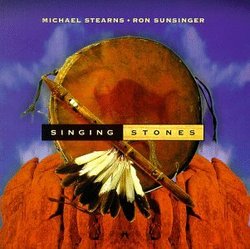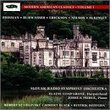| All Artists: Michael Sterns & Ron Sunsinger Title: Singing Stones Members Wishing: 0 Total Copies: 0 Label: Hearts of Space Original Release Date: 6/8/1994 Re-Release Date: 5/31/1994 Genres: New Age, Pop Style: Meditation Number of Discs: 1 SwapaCD Credits: 1 UPCs: 025041104227, 025041104241 |
Search - Michael Sterns & Ron Sunsinger :: Singing Stones
 | Michael Sterns & Ron Sunsinger Singing Stones Genres: New Age, Pop
|
Larger Image |
CD DetailsSimilar CDs |
CD ReviewsSinging Stones is amazing........ Keyote MacLean | Buckeye, Arizona United States | 06/02/2002 (5 out of 5 stars) "We first heard it on a used cassette tape we got from a local spiritual/pagan store. It was amazing....it has a way of pulling your senses backwards in time and making a connection between you, the earth and the universe. Extremely well crafted, and deftly produced, it does exactly what its creators intended. It's not just music, its an experience, one that we would recommend to anyone, especially those following the nature-based spiritual paths." Sand's Tones Christopher | Wengen-en-esprit | 12/06/2005 (4 out of 5 stars) "Singing Stones is a difficult album to review as it contains both an educational form of singing stone recording while remaining a slightly unsatisfying album as a whole. The first thing the listener must be asking is, what is a singing stone? Well, according to extremely (and possibly purposefully) vague album liner notes and outside reference articles, a singing stone is granite rock that, when struck, dragged upon, rubbed, or slapped, creates a "wonderful resonance." After years of simulating their sounds in synthesizers, Michael Stearns set out to find the recently discovered decorated rocks found in secret Native American locations. Sunsinger and Stearns recorded the sounds of these rocks, as well as "vibrations of the Earth near volcanoes." Combined with electronic and natural ambience, Lakota flutes, ocarinas, rainsticks, a druid bell, sampled voices, a smorgasbord of other fascinating instruments, and with the ubiquitous final reverbed synthesizer touches, Stearns and Sunsinger have created twelve very interesting tracks that are, surprisingly, completely independent of one another. Stearns outshines his partner in every way. While both offer collaborative tracks, Stearns's solo compositions are more complex in their aural stone latticework. Most of Sunsinger's work seems more "filler" in idea and are both simple and unimpressive in nature. The album kicks off with Sunsinger's finest effort: The Ringing Desert. He plays a haunting tune on a Lakota courtship flute (which will only be out-haunted by Stearns's Hopi flute theme on the last track). Invocation continues the dark Native themes with stormy winds and hawk cries. Stearns's Shadows & Light starts off lethargically with uninteresting stone samples; these will eventually morph into synthesized chord progressions accompanying Native vocals that will send shivers down the listener's spine. The fourth track, Petroglyphs, is described in the booklet as such: "Just stones played on-site[...]." It is of interest only to those who enjoy samples. There is no cohesion, and a good set of headphones reveals loop splices. Stone People is the track that led me to Singing Stones. I recorded it on cassette from a Hearts of Space radio program in high school. Due to a technical issue with the erase head at the time (and my lack of blank tapes), much of the Singing Stones album was recorded over Guns N' Roses tracks which were somehow lowered in volume, rather than erased. While the effect was a surreal Native American ambient rock album with Axl vocalizing along with Cahuilla singers, it caused me great grief since I was never able to hear Stephen Hill's explanation of whom the album belonged to. Six years later, by remote chance on the Internet, I heard Stone People and instantly purchased this album. It is the only song entirely built of singing stones, rather than using them as accompanying instruments. Stearns created the track himself, and the amount of effort that went into it must have been staggering. Ghost Dance is Sunsinger's low-caliber and somewhat annoying whistling tune, but he redeems himself with the collaborative Night Rocks, a fantastic after-hours desert experience. His solo Subterranean Garden is not a musical standout but actually works really well for continuing the album's somewhat eerie "lithosphere." Sunsinger is subtle with his Tibetan singing bowl, the exhaling of breath, and the reversed chime-like samples, the effects of which are ominously unsettling. Shadows is Stearns's weakest track; it is merely another Petroglyphs that adds little value to the recordings. Stearns's Honoring Stone Magic and Sunsinger's Sunrise Ceremony are major disappointments. Both composers seem to have had the same idea and used the same Native vocalist; the result is a tautology of ambient recrudescence. Finally, Stearns's incredible Return of the Red Hat completes the record with slow drum pounding, wall-shaking frequencies, glass-like ambience, and the exact same powerful chord progressions found in Shadows & Light. As an educational tool, it is interesting to hear recordings of stones that can be "played"; but without supplementary information, the listener can only wonder about the true nature of igneous instruments." Very good if you like Native American Christopher | 04/13/1999 (3 out of 5 stars) "There are several great tracks, and several not so great tracks, If I were introducing a new listner to Mike Stearns I would not choose this particular CD. Ron Sunsinger is fair and actually detracts severely from this CD"
|

 Track Listings (12) - Disc #1
Track Listings (12) - Disc #1